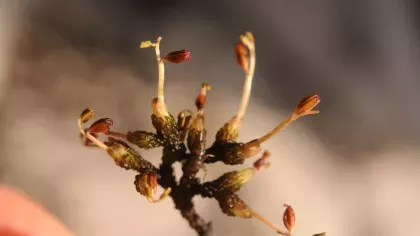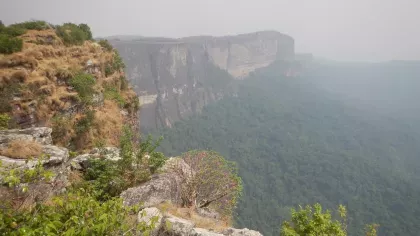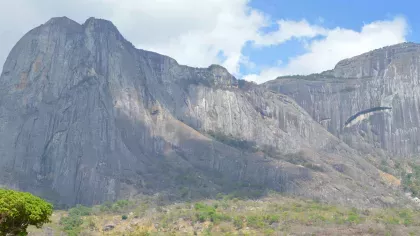24 January 2020
The plant marvels of Mozambique
How many endemic plants are found in Mozambique? Our published checklist has given us insights into Mozambique’s spectacular plant diversity.

Mozambique’s endemic plants include the beautiful, the weird and the wonderful, from a stately palm (Raphia australis) to a leopard print succulent (Orbea halipedicola).
After several years of work involving an international team of researchers, we’ve been able to put together an accurate checklist of the country’s endemic flora – a key resource for plant conservation.
Rich flora under threat
Mozambique derives its rich and varied plant life in part from its diverse geography, geology and climate, including the influence of its long stretch of Indian Ocean coastline.
This plant life supports people and wildlife, providing valuable natural resources such as timber, fibre, food and medicine, as well as essential ecosystem services including protecting Mozambique’s soils and watersheds.
However, the survival of many of Mozambique’s unique plants is threatened by human activities.
An increasing demand for agricultural land and natural resources has resulted in large areas of forest and other natural habitat being cleared, putting the country’s plant diversity at risk of being lost.
There is therefore an urgent need to identify the critical sites for plant conservation in Mozambique, which is the aim of our Mozambique Tropical Important Plant Areas project.

Herbaria, literature and fieldwork
To be able to identify these critical sites, we first need to build a record of which plants grow where.
Our current knowledge of Mozambique’s flora is based on herbarium specimens resulting from botanical fieldwork, both historical and recent, including species new to science that were only just described in 2019.
So, gathering data to put together a checklist was no small task, involving lengthy reviews of literature and herbarium research.
The pressed and dried plant specimens provide tangible evidence of where the endemic plants have been found and a wealth of information on their phenology and habitat.

Mozambique’s endemics and near-endemics
Our research found that Mozambique has 271 strictly endemic plants, these are plants that grow only within its national borders.
However, since plant distributions are not governed by political borders, and since many rare and threatened plants are distributed in Mozambique and a neighbouring country, we also detailed a further 387 near-endemics.
These near-endemics are defined using several range criteria, the aim being to include all plants for which Mozambique has a particularly high responsibility for their global survival and protection.
Just under half of Mozambique’s endemic plants are herbs while just over half are woody trees or shrubs.
Succulents feature highly including spectacular aloes and euphorbias.




Centres of endemism
Mozambique’s endemic plants are not evenly distributed throughout the country but tend to be concentrated in coastal and mountain centres of endemism.
Centres of endemism occur primarily as a result of isolation. Mountain sites that are far from other mountains provide a good example, but centres of endemism also occur elsewhere when soil and moisture conditions create isolated islands within the landscape.
Mozambique’s coastal plains support high concentrations of endemic plants, many in unusual dry coastal forests and thickets that are under increasing pressure from human activities.
The richest site for endemics in the country is the Chimanimani Mountains, a cross-border centre of endemism in Mozambique and Zimbabwe. 128 of Mozambique’s endemic plants are only found in these mountains.

Endemic and threatened?
Since endemic plants already have a restricted distribution, it stands to reason that they are more likely to be threatened with extinction than more widespread species.
In Mozambique, this seems to be the case, with more than half of the endemic plants that have been assessed being classed as threatened according to IUCN criteria.
The main threat behind this high level of extinction risk is habitat loss, driven by high population growth and a resultant increase in demand for land, agricultural products and natural resources.
This knowledge emphasises the urgent need for effective site-based conservation action and sustainable management to safeguard the future of Mozambique’s unique flora.

From checklist to conservation
Endemic plants are part of Mozambique’s natural heritage, plant species for people and government to cherish and be proud of.
Under the Convention on Biological Diversity (CBD), Mozambique is committed to national targets for documenting and conserving biodiversity.
This includes assessing the conservation status of endemic species and identifying areas of plant importance.
Our published checklist of Mozambique’s endemic plants provides baseline information contributing to meeting these targets.
Knowing which plants are endemic and threatened in Mozambique and understanding their distribution guides our ongoing work assessing Tropical Important Plant Areas and contributes the botanical component for identifying Key Biodiversity Areas.
References
Darbyshire, I., Timberlake, J., Osborne, J. et al (2019). The endemic plants of Mozambique: diversity and conservation status. PhytoKeys 136: 45 – 96.
Acknowledgements
The TIPAs Mozambique project is generously supported by Steve Lansdown CBE and Maggie Lansdown and The Jonathan and Jennifer Oppenheimer Foundation.




